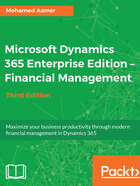
Fixed assets opening balance
The fixed assets opening balance phase has some specific considerations. To ensure accurate fixed asset opening balance, it is recommended you take into consideration the following points:
- Accurately collect the fixed assets register information: actual acquisition date, service life, current net book value, and depreciation remaining periods.
- To ensure the accuracy of fixed assets calculations, it is recommended you let the calculation be done by the fixed assets submodule in Microsoft Dynamics 365 for Finance and Operations.
- Also, consider the fixed assets that are acquired in a foreign currency, and modify the acquisition entry with the currency and the exchange rate.
The Go-Live of the fixed assets may be included in the first wave of the implementation, or it may be that the Go-Live is included in the second wave of the implementation; this is based on the agreement with the customer. On the other hand, the opening balance date may be at the beginning of the fiscal year, or it may be in the middle of the year:

In the following section, we will discuss the two scenarios of the fixed assets Go-Live in the first wave, and the second wave of the implementation.
Migrating the fixed assets in the first wave is the recommended approach where Microsoft Dynamics 365 for Finance and Operations will take care of the whole fixed assets calculations when it comes to the depreciation amounts and remaining depreciation periods without interference. This approach ensures the highest accuracy; on the other hand, it will require efforts to create old periods which only carrying fixed assets acquisition and depreciation transactions. This approach is considered as mimicking fixed asset historical transactions. The generated entries will be the acquisition account against the bridge account, and the accumulated depreciation account against the bridge account. In the case where the opening balance is in the middle of the fiscal year, the posting of depreciation should be divided into two separate tasks, as the posting of the depreciation of the current year should be linked to the accumulated depreciation and depreciation expense itself, and the bridge account will be used only against accumulated depreciation for the years prior to the current fiscal year:

Migrating the fixed asset opening balance in the second wave could be an implementation decision, considering that the opening balance of the acquisition account, the accumulated depreciation account, and the depreciation expenses are already posted with the trial balance of the first wave. Then, in the course of posting the opening balance of the submodule, this will generate entries debit, and credit acquisition account this considered a reversal of posted opening balance in trial balance, and use voucher number indication in the submodule and GL reconciliation. The depreciation entry will be posted to the accumulated depreciation account as a debit and credit, which will reverse the accumulated depreciation posted balance in the trial balance first wave:

Also, there are two options for the posting date of the fixed assets: whether to post the acquisition entry in the actual acquisition date and run the depreciation over all periods, or post the acquisition and the depreciation entry in the opening balance date.
The first approach requires the identification of the oldest acquisition date of assets to identify your very first period date in the upload sheet set service life, depreciation periods, and depreciation periods remaining; the system will then take care of the calculations from acquisition to monthly depreciation. Also, if there is any known adjustment (acquisition/depreciation), it is recommended that it is posted with its transactions type:

The second approach is posting the fixed assets acquisition and depreciation at opening balance date, which requires manual interference to update the fixed asset book actual values for acquisition, depreciation periods, and the remaining depreciation periods:
